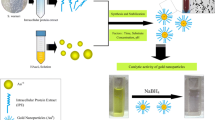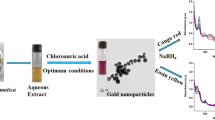Abstract
The problem of chemically synthesized nanoproducts motivated scientific community to explore ecofriendly methods of nanosynthesis. Diatoms belong to a group of aquatic, unicellular, photosynthetic microalgae have been scarcely investigated as a source of reducing and capping agents for nanosynthesis of pesticides and antibiotics. The present study reports a novel ecofriendly method for the fabrication of bioactive gold nanoparticles using locally isolated Nitzschia diatoms. The diatom-fabricated gold nanoparticles show characteristic ruby red colored with sharp absorbance peak at 529 nm. Electron microscopy confirmed irregular shape of gold nanoparticles, with average size of 43 nm and zeta potential of −16.8 mV. The effects of gold nanoparticles on diatom viability were investigated using light and electron microscopy. The mechanistic approach to shed light on how diatoms reacted after exposure to gold metal salt revealed that exposure to gold chloride triggers elevated levels of catalase and peroxidase (12.76 and 14.43 unit/mg protein, respectively) to relieve reactive oxygen species (ROS) stress induced by gold salt exposure. Investigation studies on mechanisms behind Nitzschia-mediated gold nanoparticles fabrication outlined the role of diatom proteins, polysaccharides in reduction, and stabilization of nanoparticles as confirmed by FT-IR analysis. Bioactivity of gold nanoparticles was accessed by coupling them with antibiotics (penicillin and streptomycin), which increased their antibacterial activity compared to individual nanoparticles and antibiotics (Escherichia coli, Pseudomonas aeruginosa, and Staphylococcus aureus). Overall, the present novel phyco-nanotechnological approach is a promising tool to be used as sustainable strategy in green nanotechnology as well as to reduce use of antibiotics in microbial control.







Similar content being viewed by others
References
Feurtet-Mazel A, Mornet S, Charron L, Mesmer-Dudons N, Maury-Brachet R, Baudrimont M (2015) Biosynthesis of gold nanoparticles by the living freshwater diatom Eolimna minima, a species developed in river biofilms. Environ Sci Pollut Res 23:4334–4339
Van den Hoek C, Mann DG, Jahns HM (1995) Algae. An introduction to phycology. Cambridge University Press, Cambridge, p 623
Jena J, Pradhan N, Bishnu BP, Panda PK, Mishra BK (2015) Pigment mediated biogenic synthesis of silver nanoparticles using diatom Amphora sp. and its antimicrobial activity. J Saudi Chem Soc 19:661–666
Zheng M, Huang X (2007) Biofunctionalization of gold nanoparticles. Nanotechnol Life Sci. doi:10.1002/9783527610419.ntls0004
Singh P, Singh H, Kim YZ, Mathiyalagan R, Wang C, Yang DC (2016) Extracellular synthesis of silver and gold nanoparticles by Sporosarcina koreensis DC4 and their biological applications. Enzyme Microb Technol 86:75–83
Salata OV (2004) Applications of nanoparticles in biology and medicine. J Nanobiotechnol 2:1–6
Patil CD, Borase HP, Suryawanshi RK, Patil SV (2016) Trypsin inactivation by latex fabricated gold nanoparticles: A new strategy towards insect control. Enzyme Microb Technol 92:18–25
Corti CW, Holliday RJ, Thompson DT (2007) Progress towards the commercial application of gold catalysts. Top Catal 44:331–343
Borase HP, Salunke BK, Salunkhe RB, Patil CD, Hallsworth JE, Kim BS, Patil SV (2014) Plant extract: A promising biomatrix for ecofriendly, controlled synthesis of silver nanoparticles. Appl Biochem Biotechnol 173:1–29
Luangpipat T, Beattie IR, Chisti Y, Haverkamp RG (2011) Gold nanoparticles produced in a microalga. J Nanopart Res 13:6439–6445
Thakkar KN, Snehit S, Mhatre Parikh RY (2010) Biological synthesis of metallic nanoparticles. Nanomed NBM 6:257–262
Schröfel A, Kratošová G, Bohunická M, Dobročka E, Vávra I (2011) Biosynthesis of gold nanoparticles using diatoms—silica gold and EPS-gold bionanocomposite formation. J Nanopart Res 13:3207–3216
Rietzler AC, Fonseca AL, Lopes GP (2001) Heavy metals in tributaries of Pampulha reservoir. Minas Gerais Brazil J Biol 61:363–370
Pani A, Yun SI (2016) Biosynthesis of gold nanoparticles by biotechnologically important active and inactive form of the Ascomycetes Pichia membranifaciens and Debaryomyces hansenii. J Food Chem Nanotechnol 2:92–96
Ramachandran R, Krishnaraj C, Sivakumar AS, Prasannakumar P, Kumar VKA, Shim KS, Song CG, Yun SI (2017) Anticancer activity of biologically synthesized silver and gold nanoparticles on mouse myoblast cancer cells and their toxicity against embryonic zebrafish. Mater Sci Eng C Mater Biol Appl 73:674–683
Mishra A, Tripathy SK, Yun SI (2011) Biosynthesis of gold and silver nanoparticles from Candida guilliermondii and their antimicrobial effect against pathogenic bacteria. J Nanosci Nanotechnol 11:243–248
Roshmi T, Soumya KR, Jyothis M, Radhakrishnan EK (2015) Effect of biofabricated gold nanoparticle-based antibiotic conjugates on minimum inhibitory concentration of bacterial isolates of clinical origin. Gold Bull 480:63–71
Kröger N, Bergsdorf C, Sumper M (1994) A new calcium binding glycoprotein family constitutes a major diatom cell wall component. EMBO J 13:4676–4683
Aebi A (1984) Catalase in vitro. Methods Enzymol 105:121–126
Putter J (1974) In: Bergmeyer HU (ed) Methods of enzymatic analysis, Vol 2, Verlag Chemie-Academic Press, New York, pp 685–690
Patil SV, Borase HP, Patil CD, Salunke BK (2012) Biosynthesis of silver nanoparticles using latex from Few Euphorbian plants and their antimicrobial potential. Appl Biochem Biotechnol 107:776–790
Birla SS, Tiwari VV, Gade AK, Ingle AP, Yadav AP, Rai MK (2009) Fabrication of silver nanoparticles by Phoma glomerata and its combined effect against Escherichia coli, Pseudomonas aeruginosa and Staphylococcus aureus. Lett Appl Microbiol 48:173–179
Borase HP, Patil CD, Salunkhe RB, Suryawanshi RK, Salunke BK, Patil SV (2014) Catalytic and synergistic antibacterial potential of green synthesized silver nanoparticles: Their ecotoxicological evaluation on Poecillia reticulata. Biotechnol Appl Biochem 61:385–394
Subramaniyam S, Subashchandrabose SR, Thavamani P, Megharaj M, Chen Z, Naidu R (2015) Chlorococcum sp. MM11—a novel phyco-nanofactory for the synthesis of iron nanoparticles. J Appl Phycol 27:1861–1869
Brayner R, Barberousse H, Hemadi M, Djedjat C, Yéprémian C, Coradin T, Livage J, Fiévet F (2007) Cyanobacteria as bioreactors for the synthesis of Au, Ag, Pd and Pt nanoparticles via an enzyme-mediated route. J Nanosci Nanotechnol 7:2696–2708
Hernando M, Schloss LR, Malanga G, Almandoz GO, Ferreyra GA, Aguiar MB, Puntarulo S (2015) Effects of salinity changes on coastal antarctic phytoplankton physiology and assemblage composition. J Exp Mar Biol Ecol 466:110–119
Manimaran K, Karthikeyan P, Ashokkumar S, Ashok Prabu V, Sampathkumar P (2012) Effect of copper on growth and enzyme activities of marine diatom, Odontella mobiliensis. Bull Environ Contam Toxicol 88:30–37
Siedlecka A, Tukendorf A, Skórzynska-Polit E, Maksymiec W, Wojcik M, Baszynski T, Krupa Z (2001) Angiosperms (Asteraceae, Convolvulaseae, Fabaceae and Poaceae: other than brassiacaceae). In: Prasad MNV (ed) Metals in the environment. Marcel Dekker Inc, New York, pp 171–215
Tewari RK, Kumar P, Sharma PN, Bisht SS (2002) Modulation of oxidative stress responsive enzyme by excess cobalt. Plant Sci 162:381–388
Li M, Hu C, Zhu Q, Chen L, Kong Z, Liu Z (2006) Copper and zinc induction of lipid peroxidation and effects on antioxidant enzyme activities in the microalga Pavlova viridis (Prymnesiophyceae). Chemosphere 62:565–572
Mallick N (2004) Copper-induced oxidative stress in the chlorophycean microalga Chlorella vulgaris response of the antioxidant system. J Plant Physiol 161:591–597
Asada K (1984) Chloroplasts formation of active oxygen and its scavenging. Methods Enzymol 10:422–429
Robinson MG, Brown LN, Hall BD (1996) Effect of gold (III) on the fouling diatom Amphora coffeaformis: uptake, toxicity and interactions with copper. Biofouling 11:59–79
Parial D, Pal R (2015) Biosynthesis of monodisperse gold nanoparticles by green alga Rhizoclonium and associated biochemical changes. J Appl Phycol 27:975–984
Liang J, Xia X, Zhang W, Zaman WQ, Lin K, Hu S, Lin Z (2016) Biochemical and toxicological responses of earthworm (Eisenia fetida) following exposure to nanoscale zerovalent iron in a soil system. Environ Sci Pollut Res 24(3):2507–2514
Santos-Magalhães NS, Mosqueira VC (2010) Nanotechnology applied to treatment of malaria. Adv Drug Deliv Rev 62:560–575
Acknowledgements
Authors are also thankful to UGC-SAP and DST-FIST for providing financial support to the department.
Author information
Authors and Affiliations
Corresponding author
Ethics declarations
Conflict of interest
The authors declare that they have no conflicts of interest.
Electronic supplementary material
Below is the link to the electronic supplementary material.
Rights and permissions
About this article
Cite this article
Borase, H.P., Patil, C.D., Suryawanshi, R.K. et al. Mechanistic approach for fabrication of gold nanoparticles by Nitzschia diatom and their antibacterial activity. Bioprocess Biosyst Eng 40, 1437–1446 (2017). https://doi.org/10.1007/s00449-017-1801-3
Received:
Accepted:
Published:
Issue Date:
DOI: https://doi.org/10.1007/s00449-017-1801-3




